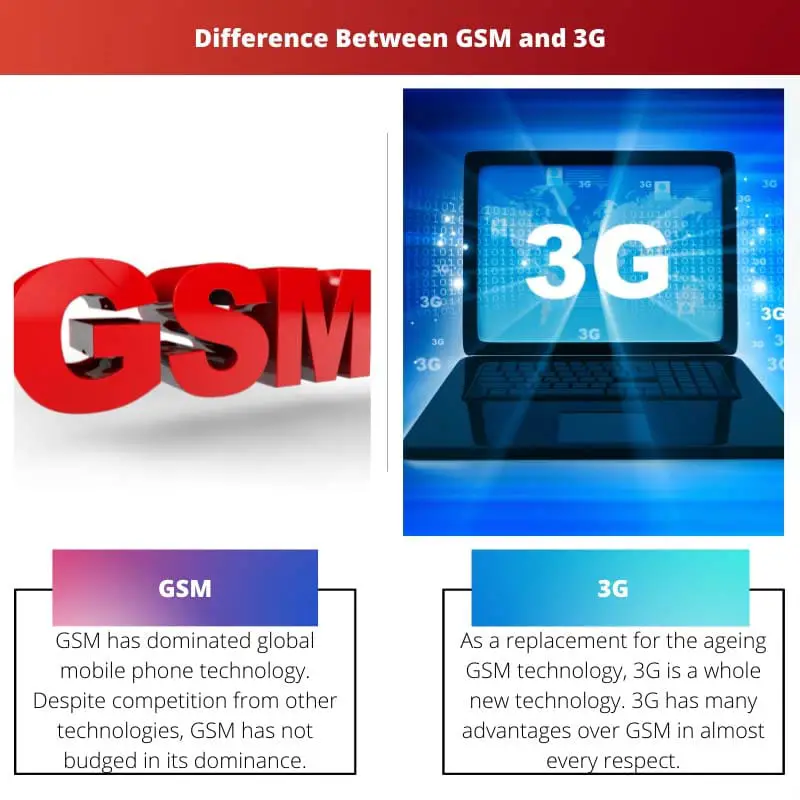Mobile communication technologies have evolved with GSM (Global System for Mobile Communication) and 3G (3rd Generation mobile technology). The use of multiple access technologies makes GSM and 3G devices capable of accessing the network, which has altered the nature of the web. Even though GSM and 3G have some similarities, they differ significantly in many ways.
Key Takeaways
- GSM is a 2G mobile communication standard, while 3G is a later, more advanced generation of wireless technology.
- 3G offers faster data transfer speeds than GSM, enabling smoother internet browsing and video streaming.
- GSM primarily supports voice calls and basic data services, while 3G supports multimedia applications and enhanced communication features.
GSM vs 3G
The difference between GSM and 3G is that they provide different data rates. The data rate or bandwidth provided by 3G technology is much higher, and they also use packet-switched data for technology. On the other hand, the data rate or bandwidth provided by GSM is much lower than 3G, and it uses circuit-switched data for technology.

GSM has dominated global mobile phone technology.
Despite competition from other technologies, GSM has not budged in its dominance. With the help of this technology, mobile phones came with many possibilities, such as text messaging and even low-speed internet access.
The next step was the introduction of GPRS and EDGE, which enhanced the capabilities of GSM networks.
As a replacement for the ageing GSM technology, 3G is a whole new technology.
3G has many advantages over GSM in almost every respect. Starting at 384kbps, mobile internet speeds for 3G networks are within the range of DSL speeds. They also use packet-switched data for technology.
The highest rate of 3G is HSDPA, which can reach speeds of 7.2mbps, much faster than GSM. Comparing different architectures, 3G introduced a Node-B node along with an RNC module in place of the existing BTSs and BSCs.
Comparison Table
| Parameters of Comparison | GSM | 3G |
|---|---|---|
| Data rate | Much lower compared to 3G. | Much higher compared to GSM. |
| Technology used | Circuit-switched data. | Packet-switched data. |
| Multiple access method | TDMA or Time Division Multiple Access, and FDMA or Frequency Division Multiple Access used. | WCDMA or Wideband – Code Division Multiple Access used. |
| Technology | 2nd generation technology. | 3rd generation technology. |
| Investment | Lower investment. | Higher investment. |
What is GSM?
GSM has dominated global mobile phone technology. Despite competition from other technologies, GSM has not budged in its dominance. GSM, called 2nd Generation (2G) mobile technology, is based on digital cellular technology.
Among other technologies introduced in the 1990s, GSM was the most popular 2G technology, compared to IS-95 in North America and PDC (Personal Digital Communication) in Japan.
With ETSI or European Telecommunication Standard Institute in 1989, the technology became the most popular technical standard in most countries.
GSM air interface uses separate frequency channels for each user to reduce interference between two users accessing the network simultaneously.
In non-concentric cells, GSM reuses the same frequency channels to minimise inter-cell interference between neighbouring cells. It supports a circuit-switched data rate of 14.4 kbps.
With the help of this technology, mobile phones came with many possibilities, such as text messaging and even low-speed internet access. The next step was the introduction of GPRS and EDGE, which enhanced the capabilities of GSM networks.
What is 3G?
As a replacement for the ageing GSM technology, 3G is a whole new technology. 3G has many advantages over GSM in almost every respect.
The IMT-2000 (International Mobile Telecommunication) specifications published by the International Telecommunication Union are the basis for 3G technology. Other continents developed their own 3G technology.
TD-SCDMA (Time Division – Synchronous CDMA) is used in China, while W-CDMA (Wideband – Code Division Multiple Access) is the standard in Europe.
While ECDMA and TD-SCDMA use frequency division duplexing, WCDMA and CDMA2000 use time division duplexing.
As per the IMT-2000 standard, the maximum data transmission rate should be 200kbps, whereas the maximum speed should be 384kbps according to the 3GPP R99 standard.
They also use packet-switched data for technology. The highest rate of 3G is HSDPA, which can reach speeds of 7.2mbps, much faster than GSM.
Comparing different architectures, 3G introduced a Node-B node along with an RNC (Radio Network Controller) module in place of the existing BTS (Base Transceiver Stations) and BSCs (Base Station Controllers).
Main Differences Between GSM and 3G
- The former provides a much lower data rate or bandwidth compared to 3G. On the other hand, the latter provides a much higher data rate or bandwidth.
- The former uses circuit-switched data for technology, whereas the latter uses packet-switched data for technology.
- TDMA, or Time Division Multiple Access, and FDMA or Frequency Division Multiple Access, are mainly used by GSM. On the other hand, WCDMA or Wideband–Code Division Multiple Access is mainly used by 3G.
- The former has compelled lower investment, whereas the latter has compelled higher investment.
- The former is considered a second-generation technology. On the other hand, the latter is considered a third-generation technology.





